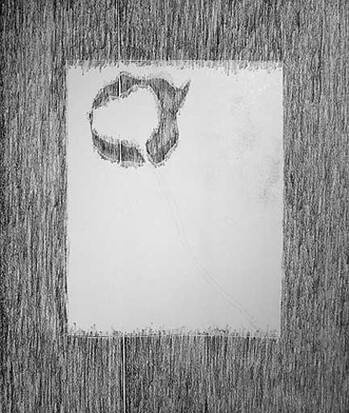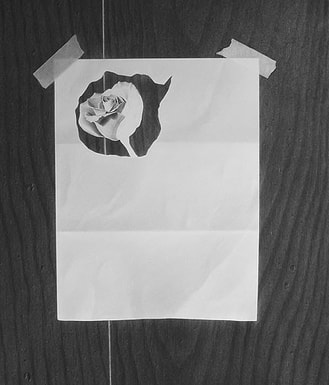
|
Learn How to Draw - Graphite Pencil and Charcoal Tutorial The drawing tutorial below contains techniques to create realistic looking artwork to provide fellow charcoal and graphite pencil artists insight into my methods. The first part will explain the pencils and blending tools I use to render both rough and smooth textures. Once you know how to create realistic looking textures, you're on you way to creating much more realistic looking artwork. The second half of the page shows a step by step tutorial of one of my drawings, so scroll down to see images of the tutorial. For more instruction, I also check out these links for my: drawing technique book, pencil drawing supplies and drawing workshops, If you feel you learn better by watching videos rather than following step-by-step pictures, please click for my Video Drawing Tutorials. |
#1 Getting Started
Once you have decided on your subject, you need to decide on the best techniques and materials to use. There are so many things to consider. Should the background stay white? Should you use a smooth paper or rough? Should you use graphite, charcoal, or a maybe a combination of both. It's enough to make you take up sculpting! Don't get discouraged. This tutorial will answer these questions and more. The first thing you need to do is analyze the textures in all the areas of your subject. Decide which areas would be considered rough and which are smooth. Notice where contrasting textures and values are adjacent to each other.Once you have identified the basic textures and values of your subject, you need to decide on the appropriate techniques to use in each area.
#2 Using Charcoal and Graphite Pencil (why I use both in each drawing)The individual granules of charcoal have an irregular shape. When light strikes a drawing containing these particles, it bounces back in many different directions. That means when it is pushed to its darkest value, charcoal doesn't have the reflective glare that is common with graphite. Usually the darkest values in a drawing are shadows, and, if you are trying to render a subject as realistically as possible, the last thing you want is a shadow that reflects more light than the subject. I use both charcoal and graphite pencil in different areas of my drawings.
Subjects I typically render with charcoal pencils:
Subjects I typically render with graphite pencils:
Once you have decided on your subject, you need to decide on the best techniques and materials to use. There are so many things to consider. Should the background stay white? Should you use a smooth paper or rough? Should you use graphite, charcoal, or a maybe a combination of both. It's enough to make you take up sculpting! Don't get discouraged. This tutorial will answer these questions and more. The first thing you need to do is analyze the textures in all the areas of your subject. Decide which areas would be considered rough and which are smooth. Notice where contrasting textures and values are adjacent to each other.Once you have identified the basic textures and values of your subject, you need to decide on the appropriate techniques to use in each area.
#2 Using Charcoal and Graphite Pencil (why I use both in each drawing)The individual granules of charcoal have an irregular shape. When light strikes a drawing containing these particles, it bounces back in many different directions. That means when it is pushed to its darkest value, charcoal doesn't have the reflective glare that is common with graphite. Usually the darkest values in a drawing are shadows, and, if you are trying to render a subject as realistically as possible, the last thing you want is a shadow that reflects more light than the subject. I use both charcoal and graphite pencil in different areas of my drawings.
Subjects I typically render with charcoal pencils:
- Wood, Bark, fur, hair, eyelashes, pupil of the eye, dark line between the lips, nostrils, cast shadows, and coarse fabrics, - like denim, leather. Charcoal can also produce smoother textures if applied with particular blenders. I'll explain more of that later.
Subjects I typically render with graphite pencils:
- Skin tones, Shading in the white of the eye, Glass, Porcelain, Light values in shiny metal, Smooth fabrics - like silk, Light shading on paper objects- like playing cards.
- Graphite:
There are many artist grade graphite pencils to choose from these days. A 2B pencil of one brand may be vastly different than the 2B of another brand. I currently use Kimberly drawing pencils which are manufactured by the General Pencil Company. These premium graphite drawing pencils are extra smooth artist quality hex shaped drawing pencils. Available in 20 degrees from 9H to 9xxB. The 9xxB is becoming one of my favorite graphite pencils. It is capable of extremely dark values with little or no graphite shine. - Charcoal:
Many people who are used to the feel of graphite effortlessly gliding across their paper find charcoal too abrasive. Currently I use Primo Euro Blend charcoal pencils manufactured in the USA by General Pencil Company. These are smoother than other charcoals I have tried. There are three degrees of hardness ranging from HB (hardest) to 3B (softest). Along with the General's Primos, I use their regular charcoals. The single most important pencil I use is the General's 2H Extra Hard Charcoal. This pencil is hard enough to get a needle sharp point, yet since it is charcoal, it is capable of very dark sharp lines. Obtaining clean sharp edges is very important in my work. All charcoal smears easily so if you are not familiar with this medium you may consider reading the chapter entitled Keeping Your Drawing Clean on page 18 of my Drawing Technique Book. - Carbon Pencils:
Carbon pencils can be used in place of charcoal in areas to separate the subject from the background. When carbon pencils are used in combination with charcoal and graphite, their inherent characteristics make them ideal for separating subjects containing similar values. Generally, I use charcoal for the background and carbon or graphite for the subjects. I currently use the new General's Primo Elite Grande #5000 and Generals Carbon sketch pencil for this purpose.









